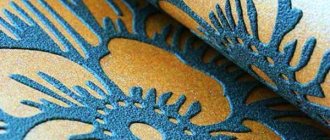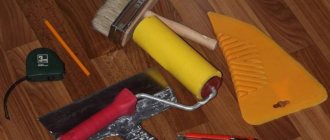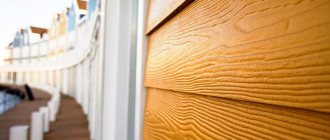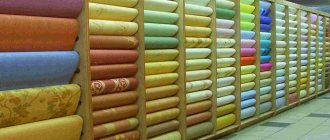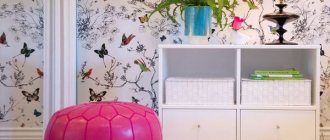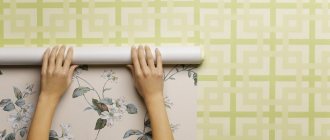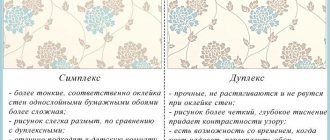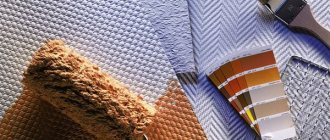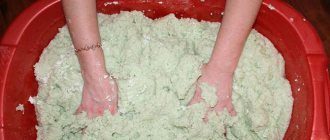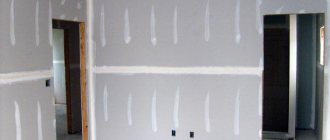This article will consider both a budget version of the wall canvas and a more expensive one. You will find out which expensive or cheap paper wallpapers you can buy. How to glue correctly, remove from walls, popular options and care features - further in the material.
In the bedroom interior
For ease of reading, the article is divided into paragraphs:
- the first part presents the differences, advantages and disadvantages of these types of wall coverings, and also examines in detail all their varieties and materials of manufacture;
- The second part presents a master class, which describes the gluing of paper wallpaper, and also gives practical advice on working with such a canvas. We will tell you about the features of care and preparation of walls. What materials and tools will be required, as well as what wallpaper glue will be optimal.
- in the third part you can find out some more useful tips, as well as familiarize yourself with the wallpaper options we presented and their prices.
Below there is navigation that allows you to quickly move to any convenient point in the article.
Pros and cons of paper wallpaper for walls - let's go deeper?
The advantages and disadvantages of paper wallpaper for walls come from their main material - paper. It has many both positive and negative properties. Next, we invite you to familiarize yourself with two tables from which you can glean the necessary information.
Large selection of wallpapers
Advantages
| Advantage | Description |
| Big variety. | This is achieved due to the ability to print absolutely any design on paper that the printing resolution allows. In addition, thanks to pressing it is possible to obtain almost any texture. It must be admitted that their appearance is rather monotonous - it is not possible to create very relief elements on every type of paper. |
| Easy to stick. | The most common adhesive for such wallpaper is suitable, easy to make, since they are light in weight. Also, often a canvas of this type does not have a particularly intricate pattern. |
| Low cost. | The low cost is dictated by the low-cost production and availability of cellulose. Cost may vary depending on the base and appearance, but is generally significantly lower than other types of wallpaper. |
Flaws
| Flaws | Description |
| Low resistance to moisture. | Low stability is manifested in the rapid wetting of cellulose under the influence of water. These wallpapers should not be placed near sources of water and steam - for example, in the kitchen or bathroom, as their service life will be significantly reduced. |
| Requiring care both during gluing and after. | Requiring care is expressed in low tensile strength, as well as easy soiling. At the same time, ordinary paper wallpaper is almost impossible to clean using conventional methods, which sometimes forces them to be re-glued. During gluing, it is necessary to maintain the temperature in the room and maintain the required humidity. |
| Low durability. | Durability depends on the coating. Ordinary paper sheets quickly fade under the influence of ultraviolet radiation and turn yellow. This is not entirely true for duplex wallpaper, but their cost is often significantly higher than simplex single-layer wallpaper. |
Historical reference
Paper wallpaper began to be made back in Ancient China. Rice paper was used for this. After the Europeans adopted this technology, they adjusted it to their needs, capabilities and materials.
At first the British only supplied hand-painted wallpaper from China. It was a huge luxury. Afterwards, in Great Britain they began to build factories for their production and decoration by hand, in contrast to the stencil painting of Europeans.
The fabric material that was used previously immediately faded into the background as soon as inexpensive and beautiful paper coverings appeared.
At the moment, the industry for the production of this paper covering is so developed that you can already buy wallpaper made of wood, fiberglass, metal, cork, bamboo, vinyl, non-woven fabric. But among this variety, paper canvases do not yield their positions and are constantly in demand, as evidenced by positive customer reviews.
Performance characteristics and properties
Wallpaper should only be used inside buildings. Wallpaper does not withstand even one season under the influence of variable humidity. Also, they should only be placed in dry rooms - in the living room, hallway or bedroom.
In the bedroom interior
In addition, this type of canvas does not stretch - it retains the shape that it was given during creation. Stretching usually ends in rupture. Wallpaper with a non-woven base is relatively stretchable, but its possibilities are also not unlimited.
Classification
Basically, paper wallpapers are classified according to their basis. Currently on the market there are mainly:
- with non-woven fabric;
- with vinyl;
- from paper.
The varieties are similar to each other with an external coating of pressed cellulose. The base primarily influences the requirements for the adhesive and surface. We invite you to look at information about all types before gluing paper wallpaper with your own hands.
On non-woven
Non-woven fabric is a durable plastic material resembling silicone. It was originally created for the textile industry, but later found wide application in finishing materials. Wallpaper with a similar base has a large number of advantages.
On non-woven fabric
Main advantages:
- ease of use. Non-woven wallpaper is much more convenient than regular wallpaper due to its strength - it is difficult to accidentally tear it. After attaching to the wall, due to the properties of the adhesive, they can be moved for some time, which allows you to accurately position the strip on the wall.
- High strength. It is achieved due to the high plasticity of the non-woven base, which firmly secures the strips to the wall. They cannot simply be torn off or deformed.
- Moisture resistance. Allows placement in damp rooms, for example, in the kitchen - non-woven fabric does not allow moisture to pass away from the walls. In addition, such wallpapers often have a duplex coating that protects the paper layer from moisture and ultraviolet radiation.
In the bedroom on non-woven fabric
This base is not without its drawbacks:
- has a lot of weight. The weight of the non-woven base is much greater than the weight of conventional wallpaper. It will require more careful finishing of the wall and stronger glue that can attach it to the wall.
- Toxic when burned. When burned, non-woven fabric releases large amounts of dioxins, which are seriously harmful to health.
- Requires special glue. It costs a little more than the usual starch-based one, and also does not always attach well to old coatings. To place on walls, it is often necessary to completely clean the surface of residues.
Classic colors
Vinyl based
Vinyl is a product of the chemical industry; its properties and appearance are more reminiscent of plastic. This species is mostly resistant to all manifestations of an aggressive environment, but has several disadvantages.
Paper-vinyl wallpaper
The biggest advantages are:
- high strength. Paper-vinyl wallpaper is available in several different layers - with a vinyl base and with a vinyl surface coating. The first option is more durable on the walls, and the second is much more resistant to light and dirt, since it can be easily washed.
- Tensile strength. Achieved through the use of vinyl - it is very plastic and can stretch to a certain extent. But, still, you should not try to test for strength, since such a canvas costs quite a lot of money.
- Practicality. Wallpaper with a vinyl surface layer is characterized by high resistance to dirt and the ability to wash.
Varieties
In addition to the main classification, several types of paper wallpaper can be distinguished, differing from each other in their shape and features. These varieties may vary in materials. These include:
- simplex;
- duplex;
- foam wallpaper;
- laminated.
First of all, the separation is based on manufacturing methods. They have specific operating conditions and require appropriate skills in operation.
Simplex
The name “Simplex” comes from the English word “Simple” - simple. This variety is the simplest single-layer coating created by rolling cellulose and painting. This is the cheapest wallpaper of all other types, as they are distinguished by their fragility.
Cheap simplex wallpaper
In order for the simplex to serve you for the longest period of time, it should be placed only in rooms with low humidity and low daylight. Ultraviolet light quickly causes paint to fade, and moisture will cause the wallpaper to peel off.
Some simplex coatings are extremely susceptible to mechanical damage, which requires additional care.
Duplex
Duplex wallpaper uses a two-layer structure. There are various combinations, for example, only paper can be used, or a combination of paper and vinyl. This type of finish is much more durable than conventional simplex wallpaper. It is possible to create different textures for them due to an additional layer.
Getting rid of bubbles
It happens that even if all the recommendations are followed, after the paper wallpaper dries, air bubbles form underneath it. If you encounter this problem, don't worry, there is an easy way to fix it. Take a syringe and fill it with wallpaper glue. We pierce the fabric where the bubble forms and fill it with glue. Use a plastic wallpaper spatula to smooth out the problem area, and then use a damp sponge to remove any remaining glue from the surface of the wallpaper. If you are not sure that you will do everything well on the first try, then try this method in the least visible place, and then work on more visible places.
How to treat the surface → Room decoration → How to choose the right paint → Surface treatment technologies → Leveling and finishing the walls → Selecting and applying a primer → Removal from the surface → Stretch ceilings and technologies → Reviews and testimonials
How to glue paper wallpaper correctly - master class!
Pasting is the simplest among all types of wallpaper. They are unpretentious and require only minimal skills and accuracy. Before gluing paper wallpaper correctly, it is necessary to carry out preparatory work:
- Costing;
- Preparation of necessary tools;
- Wall preparation;
- Selection of suitable glue and its preparation;
- Application of the canvas.
Preparing walls for gluing
The walls must be level and not have various recesses. Less attention can be paid to unevenness when using non-woven fabrics - they can hide them by filling the surface.
In addition, only dry walls should be finished - excess moisture transfers to the paper, ruining the wallpaper. Also, when drying, the putty will decrease in size, deforming the finished coating.
Preparing walls for gluing
What kind of glue is needed
Requirements are usually written on rolls. Glue for paper wallpaper with a starch base will be the best choice - due to its low weight, it can firmly hold them on the walls. Fabrics with vinyl and non-woven elements may require special adhesive that can be bonded to these surfaces.
There is no point in saving on the purchase - a product that is too cheap will not be able to retain the coating, which will ultimately lead to additional money and labor costs when restoring the wallpaper.
Consumption when gluing is approximately 250-300 grams per 7-10 square meters. You should not mix the glue for future use - it dries quickly, becoming unusable.
Quelyd super express
How to glue correctly - step-by-step instructions
This master class will show a technique that answers the question of how to hang paper wallpaper correctly using simple tools.
It is worth purchasing the material in advance. In order not to make a mistake in the number of rolls, it is necessary to measure the walls of the room in square meters. For simplicity, we recommend using our calculator for calculating the number of wallpapers (it is given above).
For gluing you will need:
- roller and brush;
- ruler with cutting groove;
- brush;
- rubber roller for smoothing joints;
- plumb line;
- a sharp wallpaper knife or a regular stationery knife.
Preparing the necessary tools
In order for gluing to proceed quickly and smoothly, it is necessary to prepare some tools in advance.
Here's what we need:
- two buckets (one for glue, the other with water);
- stepladder or stool for working with the top of the wall;
- plumb line for vertical alignment of sheets;
- scissors and a stationery knife for cutting sheets of wallpaper;
- metal ruler;
- a dry rag to remove excess glue from the wallpaper;
- glue brush;
- brush for leveling wallpaper;
- spatula for removing bubbles under wallpaper;
- rubber roller for rolling joints;
- work surface or just old newspapers for cutting and coating sheets of wallpaper.
Paintable paper wallpaper – how to choose the right one?
All such paper wallpapers are a regular canvas, usually two-layer, monotonous in color. In addition, you can also find foam wallpaper - they allow you to create an additional three-dimensional texture.
Painted paper wallpaper
Painting wallpaper is much more difficult than painting similar vinyl or non-woven wallpaper. The difficulty lies in the weak strength of the paper, and in order to achieve a good result, they must be processed very carefully.
Paper wallpaper for painting (pros and cons in the article at the link) should be glued using waterproof, high-strength adhesives. Before painting, you must wait until the canvas is completely dry. It is better to apply the paint using a roller, avoiding the formation of excess. Dries from 6 to 24 hours, depending on the thickness of the layer and the chosen paint.
How to remove from the wall?
Wallpaper is very easy to remove - just wet it with water using a cloth or spray bottle. They will begin to lag behind the walls on their own, and the most durable pieces can simply be removed from the walls with a spatula.
Remove with a spatula
You can also use a steam generator to remove paper wallpaper from the wall easily and effortlessly. Steam penetrates the paper structure very well, destroying strong bonds in the glue. This will significantly speed up the process, but it will be impossible to reuse them.
Steam generator operation
Pasting behind the heating radiator and around sockets
If it is impossible to remove the heating radiator, you should cover it on all sides with small pieces extending 8-10 centimeters beyond the edges of the radiator. If possible, it is advisable to turn off the heating and let the radiator cool while pasting, so as not to get burned in the process.
When pasting a socket or switch, you need to attach the wallpaper to the hole in the wall and if it is square, then make two cuts crosswise. If the shape is round, make several cuts crosswise (6-8) to form a kind of star.
Expensive and cheap wallpaper - what to look for when buying?
When purchasing expensive or cheap paper wallpaper, you should pay attention to:
- batches of goods;
- number of layers;
- glue requirements.
Assortment in a super market
Each batch of one model almost always differs in color and shade. In addition, on wallpaper with a pattern, its location differs in different batches, which can greatly interfere with the creation of a continuous coating. It is worth purchasing rolls of only one batch.
The number of layers affects many characteristics - strength, weight and resistance to stains. Duplex wallpapers are usually more expensive than simplex ones, but they provide great advantages compared to ordinary ones.
Requirements for glue are specified by the manufacturer. It is advisable to follow them, but in some cases, for example, with ordinary simplex wallpaper, you can get by with cheap glue with a starch base, which is extremely easy to use and unpretentious.
This is important to know
Today's market is overflowing with various offers. Manufacturers and sellers offer the modern consumer a varied selection of paper wallpapers:
- single-layer and multi-layer;
- smooth and embossed;
- with a pattern or background;
- primed (in which the design is printed on painted paper);
- unprimed (in which the design is applied to colored or white paper;
- intended for painting;
- not intended for painting.
Beauty is in simplicity
Which paper wallpaper to buy – price, catalog of the best options and their description
It is better to buy such paper wallpapers in specialized stores. There will be an opportunity to check the quality and compliance of the batch. In this case, online stores do not provide such advantages, therefore, when deciding to purchase via the Internet, you should only contact trusted companies.
Choice for every taste and color
The cost varies greatly depending on the structure. Regular simplex cheap paper wallpaper can be sold at extremely low prices - up to 50-100 rubles per roll, while duplex with embossing can cost up to several thousand rubles per roll. When choosing, price is not a critical indicator - it is better to pay attention to quality and appearance.
| Photo | Name | Price, rub | Description |
| Chelsea Designs Bramhall CD001095 | 2295 | Roll 10 m by 52 cm. Country of origin: England. Bramhall Collection. | |
| Morris&Co WE8479-2 | 6554 | Roll 10 m by 52 cm. Manufacturer: England. Texture – smooth, Morris Compendium collection | |
| Coswig Augusta 4165-02 | 490 | Roll 10.05 m by 53 cm. Manufactured in Germany. Relief surface, duplex type. | |
| Aura Treboli 583-2 | 2330 | Roll 10 m by 53 cm. Country of origin: Canada. Treboli Collection. | |
| Coswig Augusta 4119-03 | 490 | Roll 10.05 m by 53 cm. Made in Germany, Augusta collection. Duplex, relief surface. | |
| AS Creation Dekora Natur 6 958832 | 1129 | Roll 10.05 m by 53 cm. Made in Germany, Dekora Natur 6 collection. Paper on a non-woven basis with a smooth surface. |
We wish you good luck with your renovation! We hope you have figured out how to glue paper wallpaper correctly. Further in the article, a photo gallery with paper wall coverings in the interior of different apartments and houses will be presented.
Gallery of the best options in the interior of an apartment
Designer renovation with wallpaper
In the living room of a private house
In the bedroom
In a small room
In color with bed linen
Combining different paper wallpapers in a children's room
For the dining area
Play of colors in the bedroom
Like in the clouds
Golden wallpaper in a rich interior
Botanical garden on the wall
In a classic interior
In a modern house
The wind rushing down your wall
Geometry and minimalism
Chic small room design
In a village house or country house
In the attic
Pasting corners
In order not to experience problems with corners, they should be as even as possible. When pasting them, use a universal rule - never lay a whole strip (sheet) of wallpaper on a corner. The corners must be glued end to end, or at least with an overlap of 1-2 cm. This must be done because over time (1-2 years) the paper wallpaper dries out, and the natural vibrations of the house are added to this. As a result, the paper begins to stretch and peel off from the corner.
If the corners are as even as possible, then apply a sheet overlapping the adjacent wall by 1-2 cm. If they are not very even, then it is better to overlap by 3-5 cm. The next strip on the new wall must also be aligned with a plumb line or laser level. The process of gluing internal corners is shown in more detail in the video below.
Part 1
Part 2
Part 3
When gluing external corners, use the following scheme:
After gluing, cut through the overlapped edges and remove the waste as shown in the diagram.

